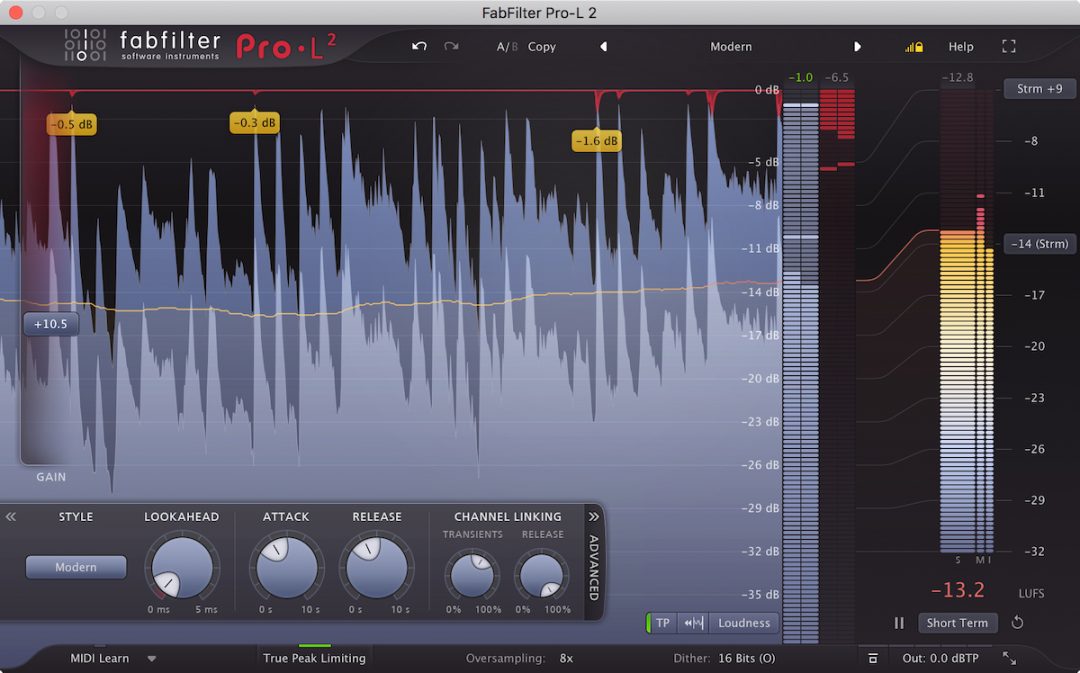True peak levels differ from the volume we read in our DAW. In digital audio, we understand the absolute ceiling to be 0dBFS (decibels relative to full scale), and any signal above that can cause clipping. We can push a mix to as high as -0.1 dBFS and never clip, right? Well, not exactly! This is where true peaks come into play; a true peak limiter can help prevent clipping we wouldn’t otherwise be aware of.
What are true peaks?
DAWs measure volume using what’s known as a sample peak program meter. The meters we see in our digital mixer show us values in dBFS, and the maximum level possible in a digital system is 0dBFS. Common sense tells us that as long as we keep our maximum values at or below 0dBFS, we can avoid clipping, which causes audible distortion and other nasty sounding business in our recordings. In reality, it’s more complicated than that.
Digital recording takes an analogue signal, then converts it to a digital one that’s stored on the computer. It captures many thousands of samples per second, as determined by the sample rate, to recreate the analogue signal. The dBFS meters in the DAW measure the peak values of these samples as they exist in the digital domain. However, they do not tell us the true peak values.
During the D/A conversion process, as a digital signal gets reconstructed back to an analogue one for playback, there can be slight variations in level. The analogue reconstruction of the signal can actually peak well above the maximum digital sample value. When that happens, we call it a true peak, or an inter-sample peak.
Regular meters and limiters don’t detect true peaks, and thus audio that exceeds 0dBFS may actually be getting into your finished mixes. In the studio listening back through decent converters, you won’t notice it. But once the file leaves the DAW and gets played back on someone else’s system, digital clipping may be apparent. It’s all the worse when converting mixes to lossy formats like MP3.
How to Avoid Inter-Sample Clipping: True Peak Limiter
Most meters and limiters only show us sample peaks; that is, the maximum value of the digital samples making up the recorded analogue signal. These don’t account for true peak values that occur once the digital signal is reconverted back to an analogue one.
The easiest way to avoid inter-sample clipping caused by D/A conversion is by using true peak meters and/or true peak limiters. A true peak meter can show us inter-sample peak values; a true peak limiter can pick them out and make sure they don’t clip. Loudness specs for post-production and broadcast usually come with a strict requirement that the program is mixed to true peak levels—not just sample peak levels.
In music, loudness specs are less strict, but it’s a good idea to understand true peak levels and how they can potentially degrade your mix depending on where it ends up. Some folks would argue that inter-sample peaks are practically unnoticeable. Because of the so-called ‘loudness wars,’ some big hits are mastered between +1 and +3dBTP (decibel true peak). That’s incredibly loud and distorted! For the best listening experience and audio quality, it’s safest to master at 0dBTP.
Conclusion
The meters in our DAW show us the maximum sample peak level of a digital signal converted from analogue. Before this signal can play back on speakers or headphones, however, it must be reconverted from digital back to analogue in a process which may introduce inter-sample clipping.
A good true peak limiter can identify inter-sample peaks and prevent them!
- SEE ALSO: Optimizing Mixes for Streaming
